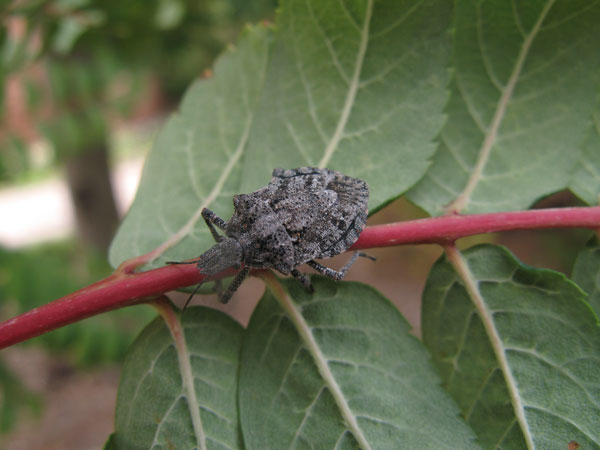Native Stink Bugs Causing Cat-Facing to Fruits

Rough Stink Bug (Brochymena sulcata)
 Thyanta, a genus of stink bug representing approximately 10 species
Thyanta, a genus of stink bug representing approximately 10 species
 Cat-facing injury caused by stink bug feeding on young fruit
Cat-facing injury caused by stink bug feeding on young fruit
HOSTS
- Apple
- Apricot
- Cane and Bramble Berries
- Cherry
- Nectarine
- Peach
- Pear
- Plum
- Many Broadleaf Crops and Weeds
DESCRIPTION
Plant-feeding stink bugs are common pests of many agricultural crops. Several different species can be found in Utah fruit orchards, including the rough stink bug, consperse stink bug, and red-shouldered stink bug. Stink bugs are sporadic pests of most fruit trees, but can occasionally cause severe damage when populations are high. The name stink bug comes from the insect’s ability to release a strong, foul-smelling odor from glands between the legs. Most stink bugs feed on plants, but a few species are beneficial predators.
The brown marmorated stink bug (BMSB) is an invasive species that is being monitored in Utah's agricultural settings by the Utah CAPs program. The Program has been found sporatic damage from BMSB in some backyard fruit trees.
BIOLOGY
Eggs are pealy white to pink and barrel shaped. They are laid on the undersides of broadleaf host leaves
Nymphs are 1/25 inch long upon hatching, color varies from dark to light with red or orange markings. They are 1/2 inch long and brown to green by the fifth instar.
Adults are about 1/2 inch long and shield shaped. Consperse stink bugs are gray-brown with black specks and yellow to green on the underside. Green stink bugs are bright green and yellow on the underside near the head and legs.
SYMPTOMS
- Cat-facing, dimpling, or deformity
- Decaying flesh
- Discolored and decayed flesh near the pit on cherries
- Scars, dimples, and depressed areas on the fruit surface
- Pithy, darkened areas
GENERAL MANAGEMENT
Stink bugs use plant hosts in addition to fruit trees for feeding, reproduction, and overwintering. Most potential problems can be reduced by appropriately managing or removing the alternate hosts.
Biological Control:
Two scelionid wasp egg parasitoids have been shown to help suppress stink bug populations in the Northwest:
- Telenomus podisi
- T. utahensis
Insecticides:
Insecticides can provide quick and effective control of piercing-sucking bug pests when their use is targeted for substantial populations at a susceptible stage of fruit development. However, repeated insecticide applications have been shown to quickly create resistance and will dramatically reduce natural enemies. Therefore, insecticides should not be used unless necessary to prevent substantial fruit damage.
When problems are detected, spot or border treatments are preferable to entire orchard sprays. Treatment can provide rapid knock-down of fruit-damaging populations, but reinfestation can occur as long as large numbers of the bugs are actively moving into orchards to feed or seek sheltered overwintering sites.

